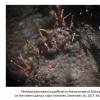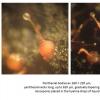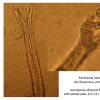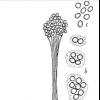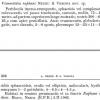
30-12-2017 19:11
 Alex Akulov
Alex Akulov
Dear colleauguesToday I finded very nice fungicolo

23-12-2017 21:00
Very small, ca. 1 mm in diam.Spores 18-22 x 7.Look

27-12-2017 23:32
 Stip Helleman
Stip Helleman
Hello,can anyone help me to get this article?J.W.

27-12-2017 18:04
 Andreas Gminder
Andreas Gminder
Hello, I have an ochraceous Hypomyces species gro

25-12-2017 20:06
Very small, ca. 1 mm in diam.Spores with 3 septers

27-12-2017 01:19
Valencia Lopez Francisco JavierHola amigosEstos Ascobolus los he recolectado en l
Fungicolous Ophiostomatoid on Diatrype
Alex Akulov,
30-12-2017 19:11
 Dear colleaugues
Dear colleauguesToday I finded very nice fungicolous Ophiostomatoid fungus, which colonise Diatrype stigma stromata. I think its something close to Sphaeronaemella, but I dont know what exactly. Also I am confused by pitted ascospores walls in my specimen. Can you advise me, what it can be?
I take this opportunity to congratulate everyone on the new 2018
Alex Akulov, Ukraine
Martin Bemmann,
31-12-2017 17:50

Re : Fungicolous Ophiostomatoid on Diatrype
Dear Alex,
did you consider the genus Viennotidia? It is synonym for some authors with Sphaeronaemella and it would be probably an undescribed species. The closest I found is V. raphani which is on germinating seeds of Raphanus. I attach the drawing and protologue by Negru&Verona 1966.
Do you have closer images of the spores, to see germ pores etc?
I wish you and the whole community a good start for 2018!
Best regards
Martin
did you consider the genus Viennotidia? It is synonym for some authors with Sphaeronaemella and it would be probably an undescribed species. The closest I found is V. raphani which is on germinating seeds of Raphanus. I attach the drawing and protologue by Negru&Verona 1966.
Do you have closer images of the spores, to see germ pores etc?
I wish you and the whole community a good start for 2018!
Best regards
Martin


